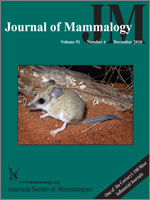The purpose of this study was to determine androgen and glucocorticoid (GC) hormonal patterns in male giant pandas (Ailuropoda melanoleuca) by monitoring gonadal and adrenal metabolites in feces. Initial validation experiments demonstrated comparable excretory patterns in urine versus feces for both androgen and GC measures. Matched urinary and fecal androgen and GC were correlated strongly with each other in a single male that was assessed over 2 years. A single pharmacological injection of adrenocorticotropic hormone caused a 15-fold GC increase in feces above baseline within 10 h, a peak at 12 h, and a return to baseline at 20 h, demonstrating the biological relationship between adrenal activation and GC excretion. Longitudinal androgen and GC excretory profiles in male giant pandas housed at North American (n = 2) and Chinese (n = 3) facilities were similar, with fecal androgens generally exceeding baseline coincident with the onset of the 5-month annual breeding season (January–June), after which values returned to nadir. Similarly, fecal GC excretion increased during the breeding season but was baseline thereafter. Fecal androgen and GC in a single male monitored through transition from subadult to sexual maturity also occurred in parallel. In this individual, basal fecal androgen and GC increased 88% and 66%, respectively, from 5 to 6 years of age. Collectively, these data demonstrate seasonal variations in gonadal activity in the giant panda by measuring androgen metabolites in feces, with elevations consistently occurring from January through June before a return to baseline for ∼4–6 months. Findings also reveal a similar temporal rise in adrenal GC patterns associated with breeding season onset, perhaps a mechanism to enhance metabolism, maximize body energy stores, and provide a competitive advantage in achieving mating opportunities. Examination of data from a single male suggests that the ability to produce these seasonal androgen and GC elevations is age dependent and occurs coincident with puberty.
How to translate text using browser tools
16 December 2010
Parallel and seasonal changes in gonadal and adrenal hormones in male giant pandas (Ailuropoda melanoleuca)
David C. Kersey,
David E. Wildt,
Janine L. Brown,
Yan Huang,
Rebecca J. Snyder,
Steven L. Monfort
ACCESS THE FULL ARTICLE

Journal of Mammalogy
Vol. 91 • No. 6
December 2010
Vol. 91 • No. 6
December 2010
adrenocorticotropic hormone (ACTH) challenge
fecal hormones
male giant panda
puberty
reproductive seasonality




